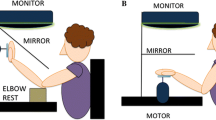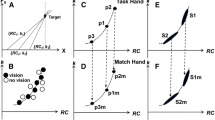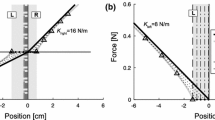Summary
The effects of an external constant force bias on the information transmitted (Ti) by the direction of isometric force exerted in 2-dimensional (2-D) space by human subjects were studied using an isometric manipulandum and random dot stereograms generated in a color display (Massey et al. 1988, Massey et al. 1990). Subjects exerted force on the manipulandum such that a visual force-feedback cursor would move in the direction of a visually defined stimulus in the stereo display. The time course of force development and the gain of directional information during increasing force intensity were also studied. We found the following, (a) When no bias force was applied, the force exerted by the subject increased from near zero to > 200 gram-force at the end of a trial and was close to the visually defined direction. When a constant bias force of 110 gram-force was applied in various directions in blocks of trials, the force exerted by the subject increased in time, as above; however, its direction also changed in time so that the instantaneous vector sum of the bias force and the force exerted by the subject pointed close to the visually defined direction. The Ti and the reaction time (RT) did not differ significantly in the two experimental conditions. These results suggest that the directional control of isometric forces is very efficient, especially in relation to visuomotor coordination, (b) The Ti was calculated at various levels of force intensity, as the latter increased from approximately 50 gram-force to 200 gram-force. There was a gain of information with force intensity for all experimental conditions studied (i.e. stereoscopic depth, absence of visual force feedback, and presence of force bias). This suggests that the specification of the direction of force improves as the force intensity increases, which could be due to a continuous comparison and correction of the force produced so that it is in the visually defined direction. The curves of Ti vs. force intensity, F, were negatively accelerating. The relation between Ti and F was a power function of the form:
where k and m are constants. Equation (1) is linear in a log-log scale:
where A = lnk. The constant m was similar but the constant A lower in various experimental conditions in which stimulus conditions were manipulated (e.g. absence of visual force feedback). In contrast, the presence of constant force bias did not affect the values of m or A. These findings indicate that the rate of gain of information (that is, the slope m in the second equation above) is very similar in different cases but that the curve is displaced to lower levels of Ti by the degradation of visual definition of the instructed force direction. Finally, application of external force bias affects neither the rate nor the amount of information gained.
Similar content being viewed by others
References
Cordo PJ (1987) Mechanisms controlling accurate changes in elbow torque in humans. J Neurosci 7:432–442
Favilla M, Hening W, Ghez C (1989) Trajectory control in targeted force impulses. VI. Independent specification of response amplitude and direction. Exp Brain Res 75:280–294
Georgopoulos AP, Kalaska JF, Massey JT (1981) Spatial trajectories and reaction times of aimed movements: effects of practice, uncertainty, and change in target location. J Neurophysiol 46:725–743
Georgopoulos AP, Massey JT (1988) Cognitive spatial-motor processes. 2. Information transmitted by the direction of twodimensional arm movements and by neuronal populations in primate motor cortex and area 5. Exp Brain Res 69:315–326
Gordon J, Ghez C (1987) Trajectory control in targeted force impulses. III. Compensatory adjustments for initial errors. Exp Brain Res 67:253–269
Kalaska JF, Cohen DAD, Hyde ML, Prud'homme M (1989) A comparison of movement direction-related vs. load directionrelated activity in primate motor cortex, using a two-dimensional reaching task. J Neurosci 9:2080–2102
Massey JT, Hovey GW, Schneider W, Chubbuck JG, Georgopoulos AP (1988) A method for studying the control of three-dimensional isometric forces using dynamic stereogram. J Neurosci Meth 26:123–127
Massey JT, Drake RA, Georgopoulos AP (1989) Isometric forces exerted by human subjects with and without bias forces. Soc Neurosci Abstr 15:173
Massey JT, Drake RA, Lurito JT, Georgopoulos AP (1990) Cognitive spatial-motor processes. 4. Specification of the direction of visually guided isometric forces in two-dimensional space: information transmitted and effects of visual force-feedback. Exp Brain Res 83:439–445
Snedecor GW, Cochran WG (1980) Statistical methods, 7th edn. Iowa State University Press, Ames IA
van Sonderen JF, van der Gon JJD, Gielen CCAM (1988) Conditions determining early modification of motor programmes in response to changes in target location. Exp Brain Res 71:320–328
Author information
Authors and Affiliations
Rights and permissions
About this article
Cite this article
Massey, J.T., Drake, R.A. & Georgopoulos, A.P. Cognitive spatial-motor processes. Exp Brain Res 83, 446–452 (1991). https://doi.org/10.1007/BF00231171
Received:
Accepted:
Issue Date:
DOI: https://doi.org/10.1007/BF00231171




